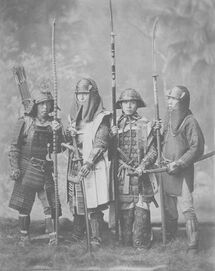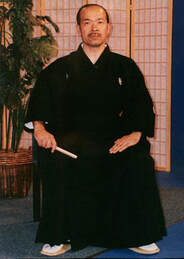KORYU BUJUTSU
Most students who begin training the gendai martial arts have little or no experience with true traditional Japanese martial arts, the 古流 武術 koryū bujutsu (lit., old-school martial-arts). The koryū were created to help ancient warriors develop the necessary physical, mental, and spiritual skills to effectively use a particular repertory of tools in mortal combat, whether on a battlefield during times of war or during peacetime, wherever law enforcement was scarce. The root of the term koryu, 流 ryū, is a small character with rich meaning.
|
流 RYU, FLOWING RIVER
Beginning in the Ashikaga period (1392-1568), formal Japanese martial art traditions are termed “ryū” (school). The Japanese term ryū comes from the Chinese ideogram or character, 流, which means "to flow" or “flowing.” This character is actually created by combining three smaller symbols: (1) at the top, a horizontal line with a circular figure immediately below it, a symbol for cloud; (2) along the left side, three dots arranged vertically, a symbol for water; and (3) in the center, three vertical lines, a symbol for river. Typically, the term 流 ryū is used as a suffix appended to the name of a martial (or any cultural) art signifying a school or system of that art. |
KORYU TODAY
Today, the number and variety of extant Japanese koryu is greatly reduced from ancient times. For this reason, we consider ourselves privileged to have received so many authentic Japanese koryu from our current soke, Tsunehisa "Shoto" Tanemura. Grandmaster Tanemura is the product of true classical training, with over 50 years of experience in the koryu bujutsu. Below is a partial list of koryu bujutsu that Soke Tanemura has mastered.
Today, the number and variety of extant Japanese koryu is greatly reduced from ancient times. For this reason, we consider ourselves privileged to have received so many authentic Japanese koryu from our current soke, Tsunehisa "Shoto" Tanemura. Grandmaster Tanemura is the product of true classical training, with over 50 years of experience in the koryu bujutsu. Below is a partial list of koryu bujutsu that Soke Tanemura has mastered.
|
Asayama Ichiden Ryu Taijutsu
Bokuden Ryu Jujutsu Daito Ryu Aiki-Jujutsu Yamamoto-Ha Gikan Ryu Koppojutsu Gyokko Ryu Kosshijutsu Tanemura-Ha Hontai Kukishin Ryu Bojutsu Hontai Yoshin Takagi Ryu Jujutsu Kijin Chosui Ryu Daken-Taijutsu Kotoh Ryu Koppojutsu Tanemura-Ha Kuki-Shinden Happo Biken Tanemura-Ha |
Kumogakure Ryu Ninpo Tanemura-Ha
Mugen Shinto Ryu Iaijutsu Nihonden Tenshin Koryu Kempo Onoha Itto Ryu Kenjutsu Shinden Fudo Ryu Taijutsu Shinden Tatara Ryu Bojutsu Shinden Tatara Ryu Taijutsu Tenshin Hyoho Kukishin Ryu Bujutsu Togakure Ryu Ninpo Tanemura-Ha Yagyu Shingan Heiho Kacchu Yawara |
Thanks to Grandmaster Tanemura, more than 20 koryu bujutsu continue to flow through history like a river.
CONTACT US
Anyone can learn traditional Japanese martial arts. All that is needed is a sincere desire to learn and perseverance. If you are sincere in your desire to learn traditional Japanese martial arts and willing to commit to regular training, we invite you to contact us.
Anyone can learn traditional Japanese martial arts. All that is needed is a sincere desire to learn and perseverance. If you are sincere in your desire to learn traditional Japanese martial arts and willing to commit to regular training, we invite you to contact us.
|
Unryu Dojo is an official branch of the Genbukan Honbu Dojo, Saitama, Japan, Shoto Tanemura headmaster (soke/soshi) and president (kancho). SamuraiTrainingCenter.com, PhillySamurai.com, and PhillyNinja.com are registered domains of Unryu Dojo. © 2009-2024 Unryu Dojo. All rights reserved. Reproduction in whole or in part in any form without express permission is strictly prohibited.
Anyone can learn traditional Japanese martial arts. All that is needed is a sincere desire to learn and perseverance. If you are sincere in your desire to learn, we invite you to contact us. |

